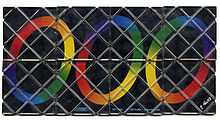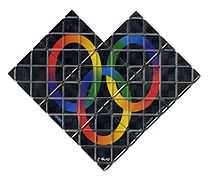Rubik's Magic

Rubik's Magic, like Rubik's Cube, is a mechanical puzzle invented by the Hungarian sculptor and professor of architecture Ernő Rubik and first manufactured by Matchbox in the mid-1980s.
The puzzle consists of 8 black square tiles (Changed to red squares with goldish rings in 1997) arranged in a 2 × 4 rectangle; diagonal grooves on the tiles hold wires that connect them, allowing them to be folded onto each other and unfolded again in two perpendicular directions (assuming that no other connections restrict the movement) in a manner similar to a Jacob's Ladder toy. The front side of the puzzle shows, in the initial state, three separate, rainbow-coloured rings; the back side consists of a scrambled picture of three interconnected rings. The goal of the game is to fold the puzzle into a heart-like shape and unscramble the picture on the back side, thus interconnecting the rings.

Numerous ways to accomplish this exist, and experienced players can transform the puzzle from its initial into the solved state in less than 2 seconds.[1] Other challenges for Rubik's Magic include reproducing given shapes (which are often three-dimensional), sometimes with certain tiles required to be in certain positions and/or orientations.
In 1987, Rubik's Magic: Master Edition was published by Matchbox; it consisted of 12 silver tiles arranged in a 2 × 6 rectangle, showing 5 interlinked rings that had to be unlinked by transforming the puzzle into a shape reminiscent of a W. Around the same time, Matchbox also produced Rubik's Magic Create the Cube,[2] a "Level Two" version of Rubik's Magic, in which the puzzle is solved when folded into a cube with a base of two tiles, and the tile colors match at the corners of the cube.[3] It did not have as wide a release, and is rare to find.
In 1996, the original version of Rubik's Magic was re-released by Oddzon, this time with yellow rings on a red background; other versions (for example, a variant of the original with silver tiles instead of black ones) were also produced, and there also was a strategy game based on Rubik's Magic. An unlicensed 2 × 8 version was also produced, with spheres printed on its tiles instead of rings. Custom versions as large as 2 × 12 have been built using kits available from Oddzon.
Professor Rubik holds both a Hungarian patent (HU 1211/85, issued March 19, 1985) and a US patent (US 4,685,680, issued August 11, 1987) on the mechanism of Rubik's Magic.
Details

It can be seen that the total number of 2 × 4 rectangles that can possibly be created using Rubik's Magic is only thirty-two; these can be created from eight distinct chains. The easiest way to classify chains is by the means of the middle tile of the puzzle's finished form (the only tile that has segments of all three rings) and the tile next to it featuring a yellow/orange ring segment (the indicator tile).
Every chain either has the middle tile on the outside (O) or the inside (I) of the chain; if it is arranged so that the indicator tile is to the right of the middle tile, then the position of the ring segment on the indicator tile can either be the upper left (UL), upper right (UR), lower left (LL) or lower right (LR) corner. The position and orientation of the remaining tiles is then determined by the middle and indicator tiles, and eight distinct chains (OUL to ILR) is obtained, although the naming convention is not standardized.
Similarly, the 2 × 4 rectangle forms of the can be categorized. Each of these forms has exactly one chain associated with it, and each chain yields four different rectangle forms, depending on the position of the edge where it is folded with regard to the middle tile. By concatenating one of the numbers 0, 1, 2 or 3 to the chain's name, depending on whether the number of tiles to the right of the middle tile before the folding edge, a categorization of the rectangle forms is obtained. The starting position, for example, is rectangle form OUR2. The cube now is rainbow and has silver rings. A game rule for this is one is you can match the silver rings and color squares, which can make it more complicated. A similar classification can also be obtained for the heart-shaped forms of the puzzle, of which 64 exist.
Records
The world record for a single solve of the Magic is 0.69 seconds, set by Yuxuan Wang of China at Beijing Spring 2011. Yuxuan Wang also holds the record for an average of five solves - 0.76 seconds set at the Beijing Summer Open 2011.[4]
See also
- Rubik's Cube
- Combination puzzles
- Mechanical puzzles
- Jacob's ladder (toy)
- Rubik's Magic: Master Edition
References
- ↑ Official World Rankings
- ↑ Rubik's Create The Cube at TwistyPuzzles.com, retrieved May 2, 2007
- ↑ Rubik's Magic: Create the Cube at Jaap's Puzzle Page, retrieved May 2, 2007
- ↑ World Cube Association Official Results - Rubik's Magic
External links
| ||||||||||||||||||||||||||||||||||||||||||||||||||||||||||||